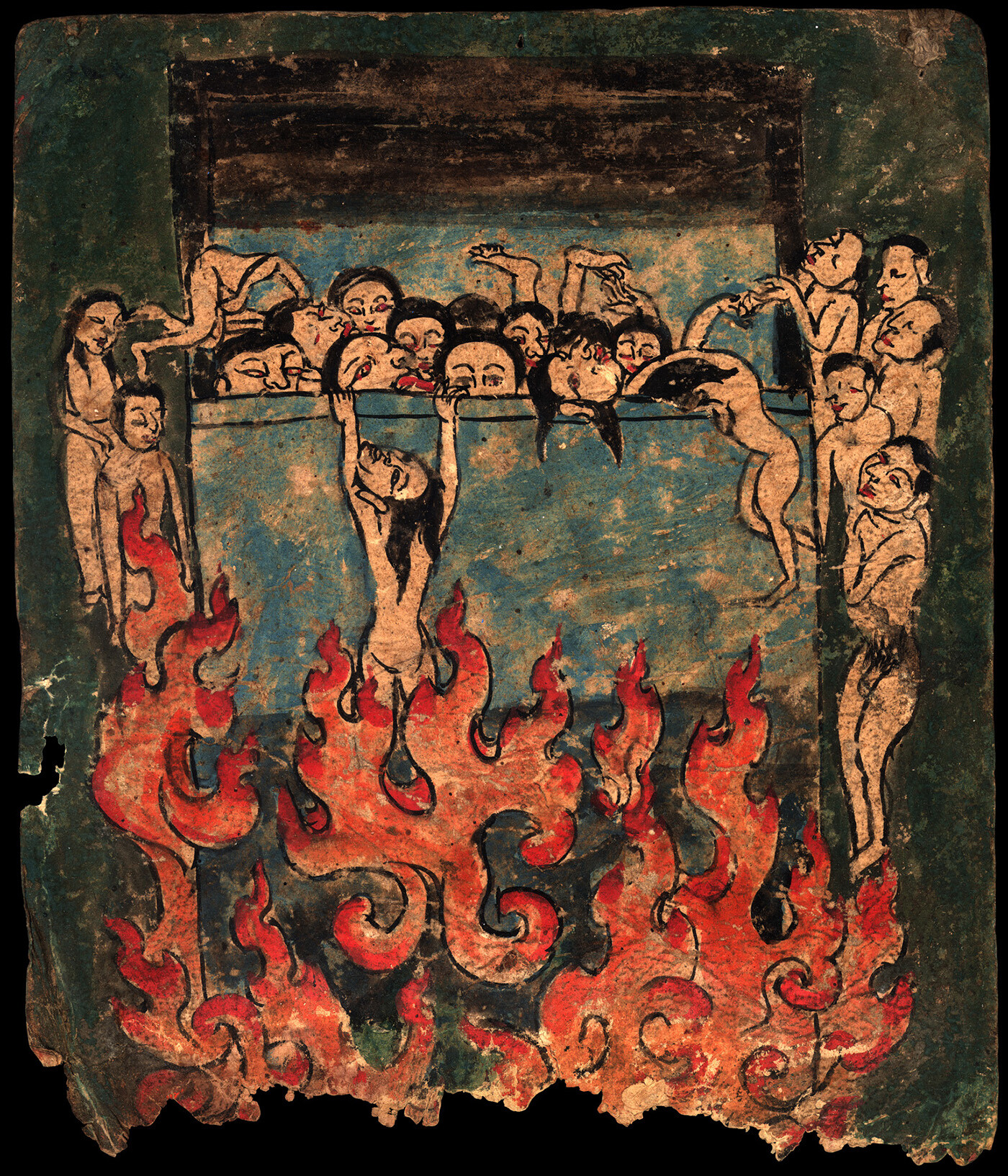This is a brief thought experiment (itself composed, or not composed, in a few agitated moments stolen away from Covid time compression) that is meant to pivot away from the dishonest romanticization and flattening of both life and death taking place in the pandemic. My earlier attempts to consider animacy worlds included reframing such phenomena as toxicity and pollution within contemporary empire as inevitably invoking racialized ulterior bodyminds, while at the same time being structurally intimate with the phobic, and sexual, politics of contagion. Perhaps I am thus predisposed to a certain stance vis-à-vis viral pandemics, such as Covid-19, which has occurred with spectacularity in part due to the globalization of popular scientific information, international public health communication, and forms of democratic (viral) media. The Covid imagination has reanimated around racialized class as well as around old East Asian disease associations in the US and elsewhere. What bodies bear the double weight of stigmatized “social” distance? (Viral) pandemics aren’t sexless; how they are (or are made) sexual is the question.

Sextoys based on H. R. Giger’s Xenomorph.

A homunculus inside a human sperm cell draw by Nicolas Hartsoaker in 1695. License: public domain.
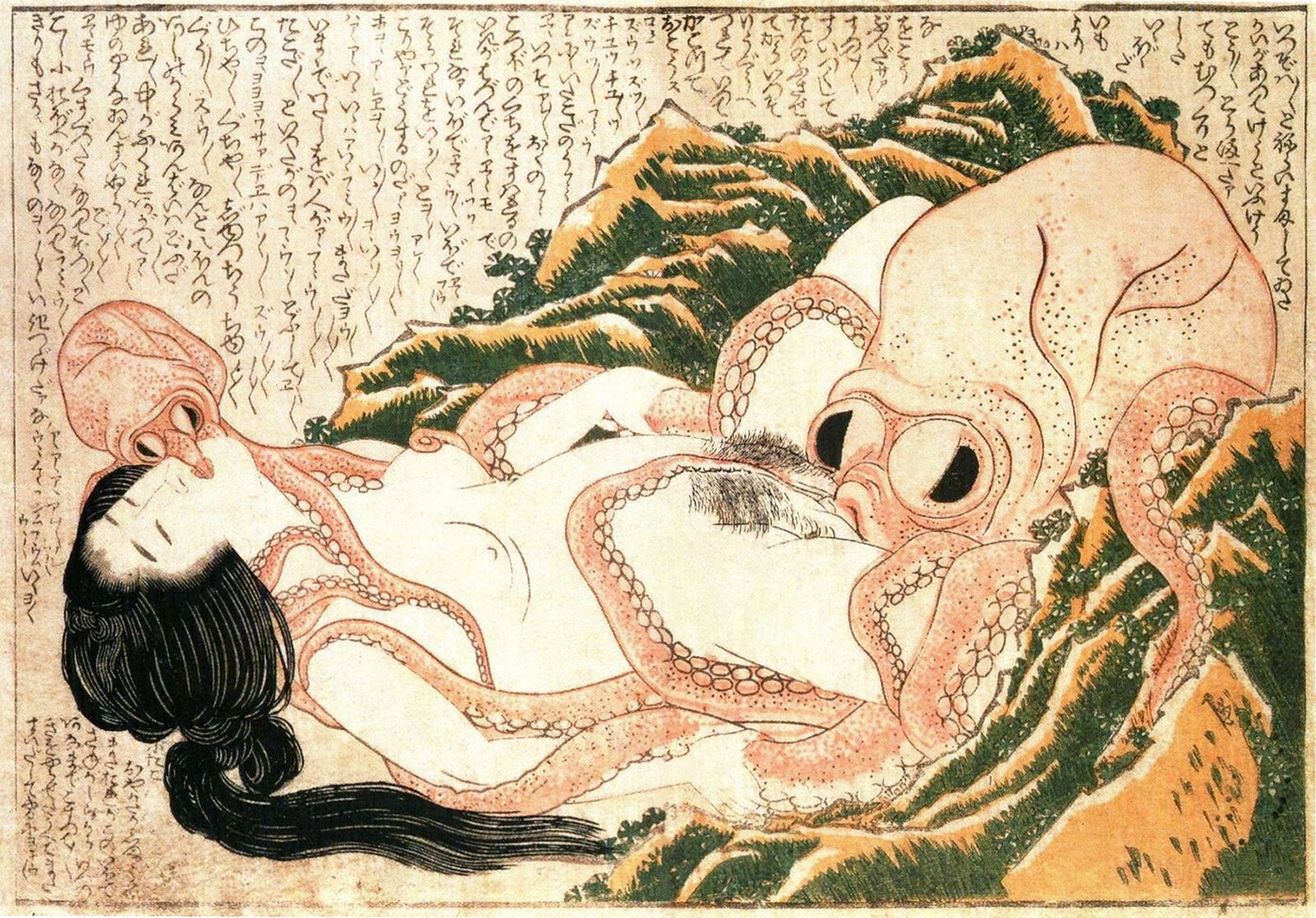
Hokusai, The Dream of the Fisherman’s Wife, 1814, woodblock print on paper. License: public domain.
Sextoys based on H. R. Giger’s Xenomorph.
Sexuality’s sheer presence as an engine (if not also a designated placeholder) of intimacy is made baldly evident when any publicized disease indicts intimacy in its dominant rendering.1 Sexual activity is again perceived as—and becomes, as an effect of that perception—at stake for disease. Though the biological potency of contact-based sex seems an easy and first-level culprit in a biocentric sphere, the stakes here can exist beside the question of biological mechanisms of infection, and it is key to remember that queerphobia opportunistically finds many venues for its articulation. The profiling of sexual activity can exist within an ordinary state of affairs in which sex, and its nonidentical partner reproduction, are given disproportionate responsibility for the imagined sustenance of life, and a presumptive muscularity in the ideal. A soundalike non-cognate for virality, virility, refers not only to masculinity but the force of health and sex drive, and sometimes sperm counts. This has an interesting parallel with viruses, in that while a male-agentive narrative mandates penetration of a “host” egg, conception is a coordinated, shared activity in the same way that many viruses themselves work (or work themselves in) commensally or mutually.
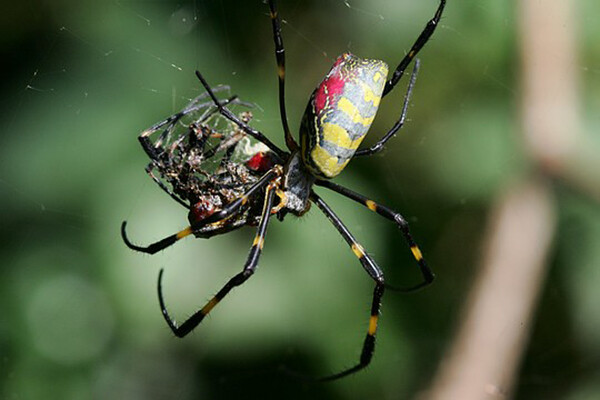

Spider cannibalism is the act of a spider consuming all or part of another individual of the same species as food. In the majority of cases, a female spider kills and eats a male before, during, or after copulation.
As for life as an object, Eben Kirksey has written of biophobic responses to Covid around the world—attacks on life understood as such, from foliage to alienable and yet proximate animal species. If sexuality inheres in majoritarian viral pandemics, then leaning on Kirksey’s terminology, I’m not sure what a “virophobic” politics—absolute, cloaking fear—has itself done definitively for the “greater good”; it has brought with it much overcorrection and biopolitical re-entrenchment. Nevertheless, viral politics are also sexual politics, not least in the human cases where certain identity-associated practices highlight queer vulnerability—such as in the case of HIV, and at the time I am writing, mpox (MPX). And they are reproductive politics in that viral reproduction is, in some ways, the “new” (not new) sex—remaking a world of life and nonlife through this reproduction, as much as any major mammalian species, including the human. The biopolitical differentiation of the lives that must be maintained in their bourgeois quality, versus the lives that must be deployed at any stake (but kept alive) for the survival of others, versus the lives that can be immediately discarded, has put the lie to the idealization of equivalent value for life in the pandemic.

Lord of the Charnel Grounds, c. early 19th century, Tibet. Courtesy: American Museum of Natural History.

A doctor draws blood from one of the Tuskegee test subjects, 1932–1972. Tuskegee Syphilis Study was a study conducted between 1932 and 1972 by the United States Public Health Service and the Centers for Disease Control and Prevention on a group of nearly 400 African Americans with syphilis. The purpose of the study was to observe the effects of the disease when untreated, though by the end of the study medical advancements meant it was entirely treatable. The men were not informed of the nature of the experiment, and more than 100 died as a result.
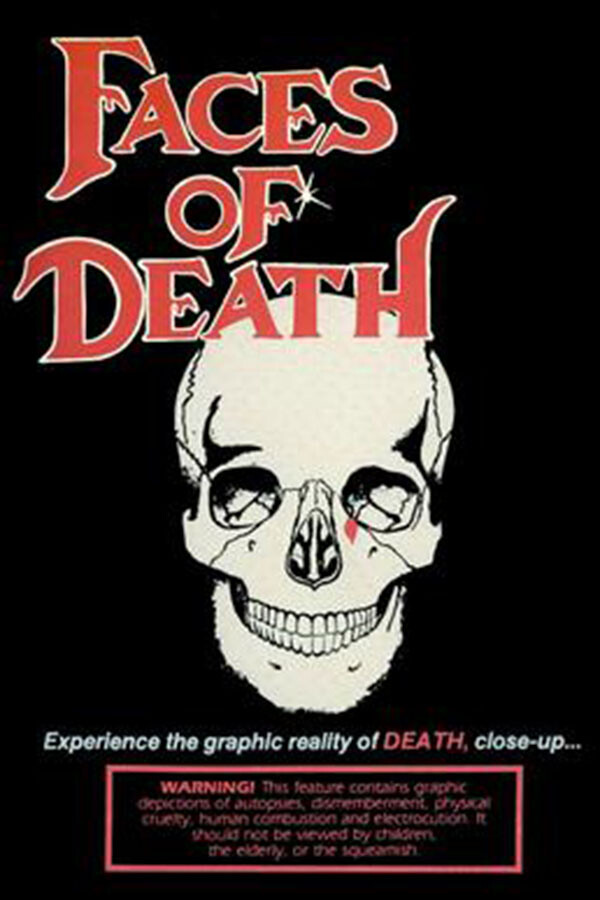
Faces of Death (later re-released as The Original Faces of Death) is a 1978 American mondo horror film written and directed by John Alan Schwartz, credited under the pseudonyms “Conan Le Cilaire” and “Alan Black” respectively. The film, shown in a documentary-like style, centers on pathologist Francis B. Gröss, played by actor Michael Carr. The narrator presents the viewer with a variety of footage showing different gruesome ways of dying from a variety of sources. Some scenes were faked for the film, while others are preexisting video footage of real deaths.
Lord of the Charnel Grounds, c. early 19th century, Tibet. Courtesy: American Museum of Natural History.
“Death by a thousand cuts” (or its rejection) might be where the title of this piece leads you, in terms of the fatalism of the scenario before many of us: an iterative, deathly, cumulative vulnerability to the Viral with a capital “V”—meaning the viruses that were detected, captured as information, treated as threat, and announced as such in publics, and furthermore isolated and targeted by biomedicine for attenuation or vanquishment. Death by a thousand cuts is the province of relentlessly exposed and/or targeted, otherwise compromised peoples who are wise to their desired or planned termination. It is also the province of thinkers richly equipped with a theoretical imagination toward a species terminus, one that has been rationally preordained by climate change’s inevitabilities, allowing that teleology to predominate all other narratives of vulnerability. But is a species terminus fairly labeled “death”? Or is this ready imaginary as much a feature of a Christian undertow that must dream of recuperative resurrection? How much is any necropolitical mandate to life/death within a “species” haunted or intensified by Christian fundaments in the West? I’m reminded here of the ecofeminist Val Plumwood’s writing on death, of the moment when she realized that she could be another’s food, and I think about the fairly late, for some, arrival to this realization.2 I further suspect that the turn to “multiverse” theory—in its predominantly binaristic, counterfactual, Western science formulation (seen in movies like Everything Everywhere All At Once and shows like Westworld)—might well have much to do with both escaping and reiterating this haunting.

The Sedlec Ossuary is a Roman Catholic chapel, located beneath the Cemetery Church of All Saints is part of the former Sedlec Abbey in Sedlec, a suburb of Kutná Hora in the Czech Republic. The ossuary is estimated to contain the skeletons of between 40,000 and 70,000 people, whose bones have, in many cases, been artistically arranged to form decorations and furnishings for the chapel.

Chapel interior. License: CC BY-SA 4.0.
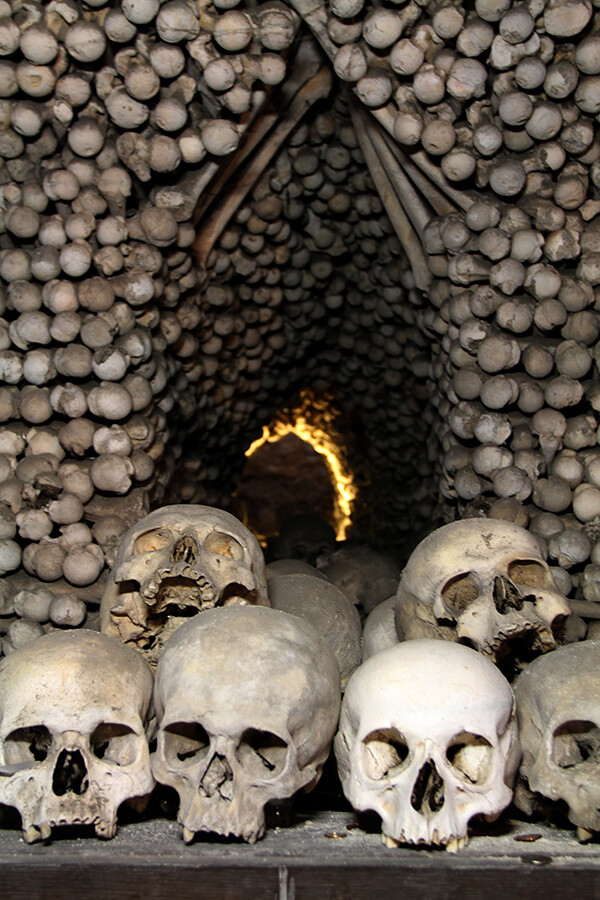
Chapel interior. License: CC BY-SA 4.0.
The Sedlec Ossuary is a Roman Catholic chapel, located beneath the Cemetery Church of All Saints is part of the former Sedlec Abbey in Sedlec, a suburb of Kutná Hora in the Czech Republic. The ossuary is estimated to contain the skeletons of between 40,000 and 70,000 people, whose bones have, in many cases, been artistically arranged to form decorations and furnishings for the chapel.
Life and death “drag” virality, despite or perhaps because of the fact that viruses’ own lively histories and their own tense marginality in these terms make them a perfect enemy. If the virus depends on “life” in the form of an available living host so that it can replicate, I want to ask about mundanely replicative stasis, not generative virility, as an opportunity to detach the virus, even if bracketed, from “life”—or for that matter, from “death,” which presents as a contingent vulnerability of the host life to severe, noncontinuable conditions imposed by the virus’s invasion. Many of the participants in virality have more to do with maintaining, sustaining, and waiting, even residing in or on the nonliving. Staving off for a moment either of these imaginaries of “life” or “death” might mean asking what ulterior “cuts” might offer a provocation worth thinking about (without a shred of evidence), including across zones of life/nonlife. Such cuts might be less available to the sciences of life, and rather be allied with forms of opacity—hence my equivocation above about evidence. I am influenced here by Sylvia Wynter’s sharp critique of the abiding biocentrism of orders of knowledge, which buttresses the colonially delineated “human” (Man), as well as the retention of a godly positioning while wearing the Enlightenment badge of secular science.3 In this continuing scheme, “human life” does not announce its colonial and racial specificity, furthering necropolitical regimes of harm. In viral theory, then, shall the cultural borrow upon the biological, a metaphorical thrust that “viral theory” as a phrase might suggest, or the biological upon the cultural—so that virality itself bears the earlier mark of the political? Wynter makes it evident that these are not the questions to ask.

World War II–era venereal disease posters. They were the product of a collaboration between the military, the Surgeon General’s office, and the War Advertising Council, a cabal of New York admen given the task of fine-tuning American propaganda.



World War II–era venereal disease posters. They were the product of a collaboration between the military, the Surgeon General’s office, and the War Advertising Council, a cabal of New York admen given the task of fine-tuning American propaganda.
My interest here is not directly related to (allopathic) public health modalities, policy recommendations, or shoring up certain populations, but is instead attuned to the relentless driving-down of vulnerable life, and driving-up of other also-vulnerable yet prioritized life. These processes seem integral to the systems of knowledge production, experimentation, and governmentality now trying their hand at viral remedy. I have little hope for reform of these systems, but also little interest in their pure destruction. I am also—perhaps we could say impotently—sidestepping the affective, virtual, statistic, or informatic “viral” so richly treated by several authors in Patricia Clough and Jasbir Puar’s excellent coedited special issue of WSQ in 2012, ten years before this special issue of e-flux journal.4


People protest against the imposition of a near-total ban on abortion by Poland’s Constitutional Tribunal. Wroclaw, Poland, October 26, 2020. Photograph: Tomasz Pietrzyk/Agencja Gazeta.
The looming specter of life/death ultimately obscures the ample perspective of alteration—when infection by the virus changes one’s life conditions and leads not to death but to a chronic settling in, to resident viral being. Chronicity is invisible in the attention to “saving life” or “preventing death,” two remarkably depraved cuts that have been richly animated in both imagination and policy. Instead, I want to think about duration, obscurity, waiting, and the chronicities that might sustain. More broadly, I wonder what a disability-centered approach to viruses might look like. I reject the assumption that disability within capitalism, particularly compounded by its relation to racialized regimes of vulnerabilization and depletion, is a ticket to disposability (it is systems of assessment about disability that seek to define it as “might as well be dead” or “I feel better, I feel more alive now”). Why not wager that disability is an occupation entirely other than life or death? Instead, disability—disability in an unmarked sense, uninterested in life or death or maybe even thriving, but in living-with, dying-with, and making do—could be imagined here as a presumptively default state in which viral presence is a negotiated sustaining (if not sustenance) among bodies. In this imagination, the viral becomes the ambient condition wherein chronicity turns not to any presumed end points but to its own proximate relations. Here, too, sex becomes otherwise: less attuned to species reproductivity (as reproductive futurity, for instance). Rather, I imagine a “cripping” of rhythms of being and making: undirection, irregular pulsations, haphazard and meandering replication, and making-do as an integral and necessary part of making. Cripping, dropped as an idea into the context of this volume without the full architecture of its production, might suggest a form of novel metaphorical craft and even a prioritizing of theoretical play—but this would be a misreading of its intent here. Rather, one of crip’s major modes is to acknowledge what is already there, the means of living and surviving that themselves facilitate forms of creative reimagining: a reworlding that has already happened. 5 These means may be experienced or recognized as forms of compromise under the weight of coloniality, but they are also challenges to conceptions of dominance, virility, and being that must be attended to, particularly, not exceptionally, during the time of a pandemic. Living with, dying with, making do, operate here by a set of cuts unimpressed by the spectacular viral.
See Priscilla Wald, Contagious: Cultures, Carriers, and the Outbreak Narrative (Duke University Press, 2008) for a US-based analysis of the stories animated within epidemiology and the greater public. Elizabeth Povinelli and her co-thinkers on the “sore,” in The Empire of Love (Duke University Press, 2006), have meaningfully gainsaid such disease narratives, as part of a bracketing of the kinds of intimacy I refer to here—more proper to what Povinelli calls “liberal settler colonies.”
Val Plumwood, “Tasteless: Towards a Food-Based Approach to Death,” Environmental Values 17, no. 3 (2008): 323–30.
Sylvia Wynter, “Unsettling the Coloniality of Being/Power/Truth/Freedom: Towards the Human, After Man, Its Overrepresentation—An Argument,” CR: The New Centennial Review 3, no. 3 (Fall 2003): 257–337.
“Viral,” ed. Patricia Clough and Jasbir Puar, special issue, Women’s Studies Quarterly 40, no. 1–2 (2012). A note on the virtual/informatic viral: N. Katherine Hayles’s “Novel Corona: Posthuman Virus,” Critical Inquiry 47, no. S2 (2021), written at the nexus of the Covid pandemic and the occasion of the Venice Biennale (which significantly attended to questions of the human), sets up a mock competition between the evolutionary strategies of humans (who are losing precipitously) and coronaviruses, wherein “on the human side are the advantages of advanced cognition, including ventilators, PPE, and, of course, the race to find a vaccine” and on the coronavirus side is rapid replication. Mock staging this may be, I wonder about the depiction of human evolutionary strategies exclusively in terms of “advanced cognition” and its further limiting to novel technologies of disease mitigation. This rendering co-conspires with a species reproductivity, even as Hayles’s argument ultimately heads towards urging a reconceiving of the scenario in terms of interdependence—which happens to be a key feature of disability justice.
Crip Genealogies, the forthcoming volume I have the fortune to coedit with Alison Kafer, Eunjung Kim, and Julie Avril Minich (Duke University Press, 2023), argues in part that to fully recognize the deep entanglement of existing forms of coloniality and disability-debility requires also rewriting histories of the fields of disability studies and other canons.
Acknowledgments: Karen Barad, Patricia Berne, Julia Bryan-Wilson, Alison Kafer, Nejat Kedir, Eunjung Kim, Eben Kirksey, Julie Minich, Michelle Murphy, Jasbir Puar, and Northwestern SPAN ’22 with Deborah Gould and Elizabeth Povinelli: in conversation or in influence, all of you have given special shape and form to my thinking for this essay even if my embrace of the scope of your thinking has met its limits.
